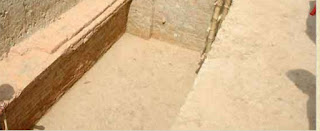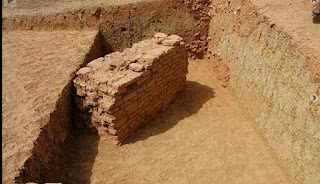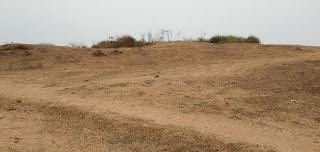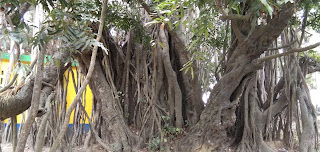This mound was discovered by Rao Bahadur Kashinath Narayan Dikshit (21 October 1889 – 6 October 1944) in 1928-29 and was lying idle for 80 years, when on 22nd March, 2010, Archaeological Survey of India (ASI) and the state’s archaeological department started a joint excavation at Chandpara mouza in Pratappur village.
Rakshashi Danga is surrounded by Sanyasi Danga, Rajbari Danga, Bhimki Tala and Nilkuthi Mound. This mound is 4.5 metres higher than Rajbari Danga which is nearby. Several wall segments forming three-room units that measure about 10m x 8m each, a narrow passage and signs of an entrance have been uncovered. The bricks used here are hand-made, about 30-36 cm long, 26 cm wide and 5-6 cm thick, such as those used in the pre-Pala era. Some of the bricks are decorated. Excavation revealed a rich haul of dull red pottery, small clay pots, objects of shell, a clay seal, pieces of stucco and lamps. The pottery fragments are home utensils like woks and bowls. Utensils for daily use made of iron and copper have also been found. Burnt clay horses, elephants and peacocks have been found here too. The clay seal found here contains inscriptions resembling that of the 3rd Century Brahmi script. According to Susmita Basu Majumdar, of Department of Ancient Indian History & Culture (Calcutta University), this Seal dates back to 7th Century and was not a Royal seal
(The other sites close by have been excavated at Rakshashi Danga (measuring 700 feet in circumference), Sanyasi Danga, Bhimki Tala in 1929-30 by Rao Bahadur Kashinath Narayan Dikshit (21 October 1889 – 6 October 1944) of the Archaeological Survey of India and Nilkuthi Mound. According to Amal Roy, the superintendent of the state archaeology department team camping at Rakshashi Danga, “None of them has been fully explored…”.




